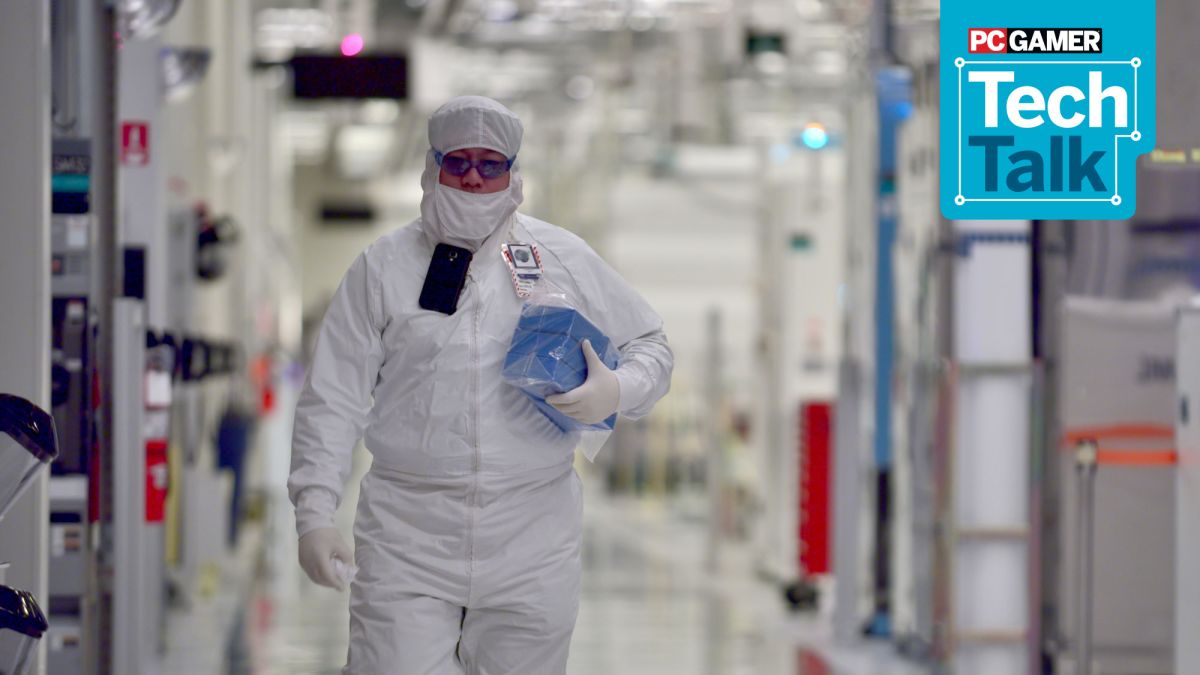Anyway, how are microchips made?
A modern PC consists of seven main components: CPU, GPU, RAM, storage, motherboard, chassis, and power supply. Each of these—yes, even this is the case—now contains anywhere from a few microchips to potentially hundreds of chips handling a variety of tasks. Audio, communications, graphics, storage, and of course the CPU, which is the central processing unit. The main building block of a modern computer is a silicon microchip, but what exactly is a microchip and how is it made? It’s a fascinating and extremely complex topic, and in this week’s tech talk I’ll be offering an ultra-lite version.
Microchips, microprocessors, CPUs, GPUs or whatever you want to call them are basically similar. They are all made of semiconductors, usually on 300mm silicon wafers, which in turn are cut from a large cylinder of silicon crystals. Where it all started, these silicon cylinders grew from seeds immersed in molten vats of almost pure silicon. However, this “almost” bit is important because small impurities in the wafer can lead to false or non-functional parts.
With microscopic features, even a small particle can be a big deal. Think about the word nano. A human hair is about 20 to 180 microns thick, or 20,000 to 180,000 nanometers. Meanwhile, the latest AMD and Intel processors have feature sizes around 7nm to 70nm (depending on what specific features we’re talking about). Even tiny dust particles can reach 2,000-5,000 nm, which is why all processor manufacturing is done in a clean room. But even then, some particles may pass through the filter.
(Image credit: Intel)
However, dust and other contaminants aren’t the only problem. The crystal structure of silicon wafers is also slightly different. It should be a perfect lattice, but the growth process causes some irregularities. Chips from the center of the wafer tend to be “better” than chips closer to the edge, which means less irregularities that can affect things like the voltage needed to hit a particular clock speed.
Due to variability and potential defects, modern microchips (especially CPUs and GPUs) have redundancy built into their designs, rather than having one faulty circuit ruin the entire chip. This makes it possible to disable certain parts of the chip, turning anything from a few to possibly hundreds of parts on or off as needed. A working chip, even if it’s slower or lacks some extra features, is better than no chip at all.
Taking AMD’s new Ryzen CPUs as an example, everything from the Ryzen 5 3600 to the Ryzen 9 3950X is built with the same 8-core CCD (Core Chipset Chip) and measures 74mm^2. Both the 3600/3600X and 3900X use a CCD with only six cores enabled, while the 3700X/3800X and 3950X use a CCD with all eight cores enabled. Why does AMD deliberately disable two CPU cores in each CCD in some parts? Improve chip yield and overall profitability.
(Image source: TSMC)
Each silicon wafer may contain hundreds of chips, but not every chip in the wafer behaves the same. After the initial manufacturing process, each wafer is diced into individual chips. The chips are then tested to determine how each chip performs in a process called binning. Some might work just fine, some might actually be useless (too many dead pixels), and many fall somewhere in between these extremes.
The percentage of functional chips is yield. Most companies don’t report their chip yields directly, although rumors and estimates suggest that Intel’s first-generation 10nm process (for the discontinued Cannon Lake CPUs, not to mention the Core i3-8121U) is in the single digits.In other words, less than 10% of potential 10nm processors are viable — here’s how Rear Intel disabled the Gen10 graphics and came with a small dual core chip! By comparison, it is estimated that production of AMD’s new Zen 2 parts could reach 85 percent or more with the harvest of partially functional molds.
This is important because each wafer produced has a relatively fixed cost—perhaps $7,000 to $10,000 or more. This is also why smaller chips are traditionally preferable to larger chips, since more chips can fit in the space of the wafer. A 74mm^2 chiplet like the Zen 2 has the potential of nearly 800 chips per wafer, while Intel’s 10-core Skylake-X chip is about 322mm^2 and can only fit about 170 chips per wafer. With a defect density of 0.1/cm^2, a 10-core Skylake-X could lose as much as a third of potential chips (no gain), compared to around 8% for a Zen 2 CCD.
Rest in peace, Lake Cannon. (Image credit: Intel)
Binning addresses multiple aspects of the chip. The first is the gain of a partially functional chip – so the RTX 2060 using the same TU106 GPU as the 2070 only has 30 of the potential 36 SMs enabled, and two memory controllers disabled. Binning also determines the ideal voltage and frequency, and sometimes a fully functional chip can degrade because it can’t run at the desired speed. AMD’s RX 5700 and RX 5700 XT use the same Navi 10 GPU, but aside from 256 fewer cores, the 5700 is clocked around 150-200MHz lower. Instead, the RX 5700 XT 50th Anniversary Edition gets a higher graded chip, boosting the base and boost clocks by 75MHz.
Simply put, the best chips are sold in the fastest, most expensive parts. At the same time, chips that are functional but may not be as sold as low-end products. Depending on how intensive and precise the grading process is, the gap between the “best” and “worst” functional chips in the wafer can be relatively small. Mature process nodes like TSMC’s 12/16nm or Intel’s 14nm++ usually get very good yields and relatively similar performance parts. Newer manufacturing nodes like TSMC’s 7nm or Intel’s upcoming 10nm (round 2) often have a wide gap between “good” and “mediocre” parts.
I touched on this in my Radeon RX 5700 review, but generally all of the above means you won’t hit the same clock speeds on a second or third tier, no matter how hard you overclock. This is also what I see in the CPU. My Intel Core i9-9900K sample hit 5.1GHz on all cores (with adequate cooling), or 5.0GHz on a modest liquid cooling solution. Meanwhile, the i7-9700K and i5-9600K samples top out at 4.9GHz. Sure, it’s only 100MHz, but that’s a $150 difference compared to other identical chips. AMD’s Ryzen processors exhibit similar behavior, with the 3900X able to reach slightly higher clock speeds than the 3700X and 3600X.
(Image credit: AMD)
However, there is a problem. Sometimes you can be lucky enough to win the silicon lottery with a good chip sold as a second tier part. After binning and harvesting chips, sometimes a company has too many “good” chips and not enough “bad” chips. Since the performance difference of first- and second-tier parts may be only 5-10%, but the price difference may be 20% or more, customers usually buy more chips with lower prices. Some higher quality parts are downgraded and sold as less expensive parts if not enough “bad” chips are available.
In the past, downgrades can sometimes be reversed – AMD used to have 2-core and 3-core CPUs, and if you were lucky, you could turn them into working 4-core parts. This is usually no longer possible because the extra cores on the CPU and GPU are disabled in a way that cannot be turned back on, but you can still get lucky with the better parts of overclocking. There are even companies that pre-test CPUs and sell “special” chips at higher prices, effectively eliminating the lottery aspect of charging.
If all you want is a working PC, then you probably don’t need to know any of the above details. You get what you pay for, the fact that your CPU may have two cores disabled doesn’t matter. For PC enthusiasts, on the other hand, it can help determine which parts to buy to build the ultimate rig, and why some parts are better for overclocking than others. It also helps explain why larger CPUs and GPUs are so expensive. Yes, Nvidia earns a lot more from the RTX 2080 Ti than the RTX 2060, but the 2080 Ti can easily be more than twice as expensive to manufacture.
Check more articles in our categories Gaming & News et Anime.
Thanks for visiting we hope our article Anyway, how are microchips made?
, don’t forget to share the article on Facebook, twitter and e-mail with the hashtag ☑️ #microchips ☑️!














Leave a Review